人教版英语九年级unit7单元知识点
人教版九年级英语Unit7单元知识点课件
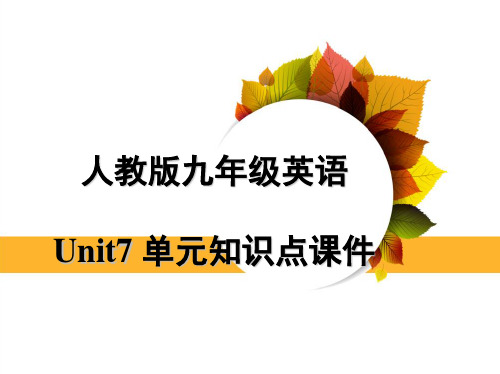
Section A
知识点一 allow的用法和搭配 教材原文 I don ' t think sixteen-year-olds should be allowed to drive.我 觉得不应该允许十六岁的青少年开车。 allow作动词,意为“允许;准许”,常见的搭配是allow sb. to do sth.“允许某 人做某事”,其中to do sth.作动词allow的宾语补足语。 My parents don ' t allow me to go out at night. 我父母不允许我夜里出去。
My watch doesn ' t work. I ' ll have it
(repair).
解析 本题考查have sth. done的结构。句意:我的手表不走了,所以我将 找人把它修理一下。根据get/have sth. done“让别人做某事”的结构可
知,所缺的词是repair的过去分词repaired。
知识点七 get in the way of的固定搭配 教材原文 But sometimes these can get in the way of their schoolwork... 但有时这些会妨碍他们的功课……。 get in the way of是固定搭配,意为“挡……的路;妨碍”。 Never let the reality get in the way of your dreams. 不要让现实挡住了你的梦想。 Playing computer games for long got in the way of my schoolwork.长时间 玩电脑游戏妨碍了我的功课。
Unit 7 Teenagers should be allowed to choose their own clothest .
(完整word版)人教版九年级英语第七单元知识点归纳

Unit 7 Teenagers should be allowed to choose their own clothes一、必记单词①名词:license 证,证件safety安全,安全性field田野,场地poem诗,韵文community社区,社团chance机会,可能性society社会choice选择,挑选②动词:educate教育,训导manage完成(困难的事);应付(困难局面)enter进来,进去③动词&名词:smoke吸烟,冒烟;烟cry哭,叫喊hug拥抱,搂抱lift举起,太高;电梯regret感到遗憾;懊悔,后悔support支持④ 形容词:tiny极小的,微小的awful很坏的,讨厌的⑤副词:badly严重地;差;非常;二、短语Have part—time jobs 做兼职工作get earshot pierced 扎耳洞Talk back回嘴,顶嘴keep。
.。
away from避免接近,远离Make one’s own decision自己做决定get in the way of挡..。
的路;妨碍Have nothing against 不反对be serious about认真对待三、小语法讲解:1.No way!不行!No way意为“不行”,这是英语口语中一个直接拒绝对方的表达用语,强调不能按照他人的要求去做某事或不允许别人做某事。
Can I borrow your bike?No way!2.I don’t think sixteen-year—olds should be allowed①宾语从句跟在think,believe,suppose,expect等动词后,当主句是一般现在时,且主句的主语是第一人称(I,We)时,变否定句时,要否定主句,而不是从句,我们称之为“否定前移”;变反意疑问句时,附加问句要与从句一致。
I think you are rightI don’t think you are rightI don’t think he is clever,is he?注意:如果主句的主语是第二,第三人称,变否定句时,要在从句否定;变反意疑问句时,附加句要与主句一致。
新人教版九年级英语unit7课文知识点讲解

★重点短语1、take the test 参加考试2、pass the test 通过考试3、fail a test 考试失败4、be strict with+人对某人严格be strict in+事物对某事要求严格5、stay up 熬夜6、have an opportunity to do sth.有机会做某事=have a chance to do/ of doing7、every other day每隔一天(每两天)8、clean up 打扫整理9、learn from each other 互相学习10、concentrate on 专注于11、one’s own 某人自己的12、the other day 前几天,几天前= a few days ago= every two days13、at present 现在,目前14、in this way 用这种方法15、in the way 挡道的,妨碍人的16、on the way 在路上17、on one’s way to 在某人去…的路上18、by the way 顺便说(问)19、be serious about 对…认真20、care for在乎、关心Unit 7: Teenagers should be allowed to choose their own clothes.1. allow允许allow + n. 允许某事allow sb. to do sth. 允许某人做某事(主动语态)如:妈妈允许我每晚看电视。
allow doing sth. 允许做某事如:They don't allow smoking here.be allowed to do sth. 被允许做某事(被动语态)如:莉莉被允许去青岛。
2.I don’t think sixteen-year-olds should be allowed to drive.宾语从句中否定转移:若宾语从句跟在think, believe等表示“想,认为"的动词之后,而主语为第一人称时,句子的否定体现在主句上。
人教版九年级英语unit7知识点

人教版九年级英语unit7知识点除了知识和学问之外,世上没有其他任何力量能在人们的精神和心灵中,在人的思想、想象、见解和信仰中建立起统治和权威旅游是知识之路。
下面给大家分享一些关于人教版九年级英语unit7知识点,希望对大家有所帮助。
人教版九年级英语unit7知识1单词license [?laIsns ] n. (= licence) 证;证件safety [?seifti] n. 安全;安全性smoke [sm?uk] v. 冒烟;吸烟 n. 烟part-time [?pɑ:(r)t ?ta?m] adj.兼职的pierce [pi?s][pirs] v. 扎;刺破;穿透earring [?i?ri?][??r??] n. 耳环;耳饰flash [fl??] n. 闪光灯;闪光 v. 闪光,闪耀tiny ['ta?n?] adj. 极小的,微小的cry [kra?] v. & n. 哭;叫喊field [fi:ld] n. 田野;场地hug [h?g] n. & v. 拥抱;搂抱lift [lIft] v. 举起;抬高 n. 电梯;搭便车badly [?b?dli] adv. 严重地;差;非常talk back 回嘴;顶嘴awful [??:fl] adj. 很坏的;讨厌的teen [ti:n] n.(13至19岁之间的)青少年regret [ri?gret] v. 感到遗憾;懊悔poem [?p?uim] n. 诗;韵文community [k??mju:n?ti] n. 社区;社团keep away from 避免接近;远离chance [t?a:ns] [t??ns] n. 机会;可能性make one’s own decision 自己做决定educate [?ed?ukeit] v. 教育;教导manage [?m?nid?] v. 完成(困难的事);应付(困难局面) society [s??sai?ti] n. 社会get in the way of 挡……的路;妨碍support [s??p?:(r)t] v. & n. 支持enter [ent?(r)] v. 进来;进去choice [ts] n.选择; 挑选Picasso [pi'k?s?u] 毕加索(西班牙画家)人教版九年级英语unit7知识2知识梳理【重点短语】1.get his driver’s license 取得驾驶执照2.no way没门,不行3.sixteen-year-olds 十六岁的人sixteen-year-old 十六岁的4. be worried about=worry about 担5. have part-time jobs 做兼职工作6. get one’s ears pierced 打耳洞7. get / have / make sth. done 使某物被做……8. stop doing sth 停止做某事9. stop to do sth. 停下来去做某事10. spend time with sb. 花时间和某人在一起11.take photos, take a photo 照相e a flash 使用闪光灯13.all night 整夜14.stay by my side 呆在我身边15.make sure = be sure 确保,确定16.keep sb. (away) from sth使某人远离某物17. hurt oneself 伤害某人自己18. give sb. a hug = hug sb. 拥抱某人19.lift sb.up 举起某人20. cough badly 剧烈地咳嗽21. talk back 回嘴22. an adult 一个成人23. think back to 回想起24. regret doing sth. 后悔做了某事25. make one’s own decision 做某人自己的觉得26.too + adj.+ to do sth. 太…而不能做某事27.learn…from…从…...学到…...8.agree with sb 同意某人的观点29.disagree with sb. 不同意某人的观点30.move out 搬出去【重点句型】1.I don’t think twelve-year-olds should be allowed to get their ears pierced.我认为不应该允许12岁的孩子穿耳孔。
人教版九年级英语Unit7知识点归纳
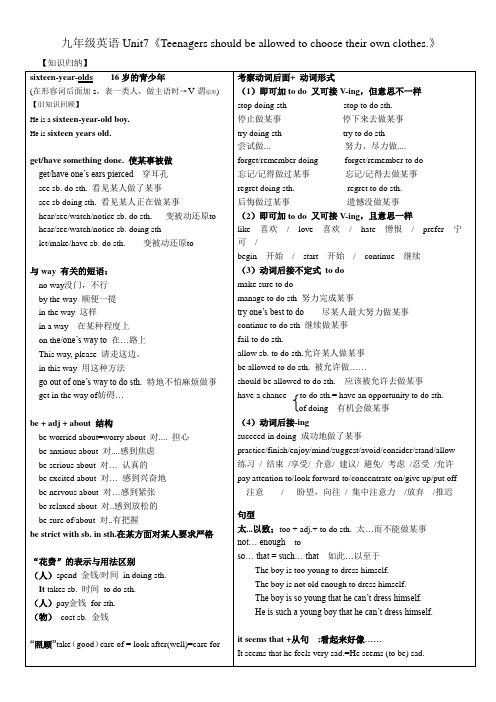
manage to do sth努力完成某事
try one’s best to do尽某人最大努力做某事
continue to do sth继续做某事
fail to do sth.
allow sb. to do sth.允许某人做某事
be allowed to do sth.被允许做……
so… that = such… that如此…以至于
The boy is too young to dress himself.
The boy is not old enough to dress himself.
The boy is so young that he can’t dress himself.
【反义词】disagree with sb.不同意某人的观点
【派生词】n. agreement--- disagreement
be in agreement意见一致
与keep有关的用法
keep sb. (away) from sth使某人远离某物
keep out不让进入
keep sb./sth.+adj.使…保持
at the end of-----at the beginning of
in the end=at last=finally最后
by the end of …
“足够”
形容词+enough(这一点还是比较容易出题的)
如:beautiful enough足够漂亮
enough+名词
如:enough food足够食物
考察动词后面+动词形式
(1)即可加to do又可接V-ing,但意思不一样
人教版九年级英语全册Unit7知识点
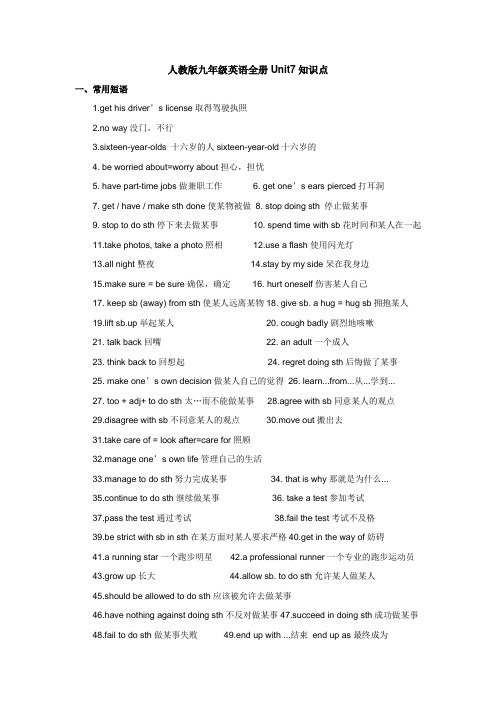
人教版九年级英语全册Unit7知识点一、常用短语1.get his driver’s license取得驾驶执照2.no way没门,不行3.sixteen-year-olds 十六岁的人sixteen-year-old十六岁的4. be worried about=worry about担心,担忧5. have part-time jobs做兼职工作6. get one’s ears pierced打耳洞7. get / have / make sth done使某物被做8. stop doing sth 停止做某事9. stop to do sth停下来去做某事10. spend time with sb花时间和某人在一起11.take photos, take a photo照相e a flash使用闪光灯13.all night整夜14.stay by my side呆在我身边15.make sure = be sure确保,确定16. hurt oneself伤害某人自己17. keep sb (away) from sth使某人远离某物18. give sb. a hug = hug sb拥抱某人19.lift sb.up举起某人20. cough badly剧烈地咳嗽21. talk back回嘴22. an adult一个成人23. think back to回想起24. regret doing sth后悔做了某事25. make one’s own decision做某人自己的觉得26. learn...from...从...学到...27. too + adj+ to do sth太…而不能做某事28.agree with sb同意某人的观点29.disagree with sb不同意某人的观点30.move out搬出去31.take care of = look after=care for照顾32.manage one’s own life管理自己的生活33.manage to do sth努力完成某事34. that is why那就是为什么...35.continue to do sth继续做某事36. take a test参加考试37.pass the test通过考试38.fail the test考试不及格39.be strict with sb in sth在某方面对某人要求严格40.get in the way of妨碍41.a running star一个跑步明星42.a professional runner一个专业的跑步运动员43.grow up长大44.allow sb. to do sth允许某人做某人45.should be allowed to do sth应该被允许去做某事46.have nothing against doing sth不反对做某事47.succeed in doing sth成功做某事48.fail to do sth做某事失败49.end up with ...结束end up as最终成为50.practice doing sth练习做某事51.see sb. do sth看见某人做了某事52.spend time on sth在某事上花时间spend time in doing sth在做某事上花时间53. care about sb关心某人54.talk with sb. about sth.和某人谈论某事55.make a choice做选择56.have a chance to do sth有机会去做某事二、短语用法集锦1.She is a sixteen-year-old girl.=She is sixteen years old.2. allow sb. to do sth. 允许某人做某事(主动语态)be allowed to do sth. 被允许做某事(被动语态)Mother allows me to watch TV every night.LiLy is allowed to go to America.3. get their ears pierced 穿耳洞让/使(别人)做某事get sth. done(过去分词) have sth. doneI get my hair cut. == I have my hair cut.4. enough 足够形容词+enough 如:beautiful enough足够漂亮enough+名词如:enough food 足够食物enough…to 足够…去做…例:I have enough money to go to Beijing. 我有足够的钱去北京。
人教版九年级英语第七单元知识点梳理

人教版九年级英语第七单元知识点梳理Unit 7 Teenagers should be allowed to choose their own clothes.一、短语:1.part-time jobs兼职工作2.a driver’s license驾照3.at that age在那个年纪4.on school nights在上学期间的晚上5.clean up清扫6.get in the way of挡道、妨碍7.at most最多8.the other day前几天9.all my classmates我所有的同学10.concentrate on全神贯注于11.be good for对…有益12.in groups成群的, 按组13.get noisy吵闹14.learn from向...学习15.at present目前, 现在16.have an opportunity to do有做……的机会二、知识点:1.allow sb.to do sth.:允许某人做某事, 如:Mother allows me to watch TV every night.妈妈允许我每晚看电视。
be allowed to do sth.: 被允许做某事(被动语态), 如:LiLy is allowed to go to Qinzhou.莉莉被允许去钦州。
2.get sth.done: 让/使(别人)做某事, 如get myears pierced穿(我的)耳洞。
3.enough: 足够, 形容词+enough(这一点比较容易出题), 如: beautiful enough足够漂亮。
enough+名词, 如: enough food足够食物4.stop doing sth.: 停止正在做的事, 如Please stop speaking.请停止说话。
stop to do sth.:停止一件事去做另一件事, 如Please stop to speak.请停下来说话。
Unit7单词句型知识点汇总人教版九年级英语全册

Unit 7一、单词1.license n.证件2.safety n.安全;安全性3.smoke v.吸烟n.烟雾4.parttime adj.兼职的5.earring n. 耳环6.pierce v. 刺破;穿透7.flash n.闪光灯v.闪耀8.tiny adj.细微的9.cry v.哭喊10.field n.田野11.lift v.举起;抬高n.电梯;便车12.hug v&n. 拥抱13.poem n. 诗文14.badly adv.严重地;差15.awful adj.很坏的;讨厌的16.regret v&n 懊悔17.society n.社会18.munity n.社区;社团19.chance n.机会;可能性cate v.教育;引导21.support v&n支持22.manage v.完成;应对23.enter v.进入24.choice n.选择;挑选二、重点句子1.Teenagers should not be allowed to smoke. 不应该允许青少年吸烟。
2.Sixteenyearolds should be allowed to get their ears pierced. 应该允许十六岁的青少年打耳洞3.I don’t think sixteenyearolds should be allowed to drive. 我觉得不应该允许十六岁的青少年开车。
4.They aren’t serious enough. 他们不够认真。
enough的用法:名前形副后5.Me,too! 我也一样!6.It's the only thing I’ve ever wanted to do. 它(赛跑)是我唯一想做的事情。
7.They always talk about what will happen if I don’t succeed.他们总是谈论如果我没有成功将会发生什么。
人教版九年级全一册英语Unit7单元语法知识点总结

人教版九年级全一册英语Unit7单元语法知识点总结本单元重点短语的具体用法1. get his driver’s license:取得驾驶执照。
例如:He finally got his driver's license after many attempts.(经过多次尝试,他终于拿到了驾驶执照。
)2. no way:没门,不行。
例如:- Can I have a day off?(我能请一天假吗?)- No way!(不行!)3. sixteen-year-olds:十六岁的人,是一个复数名词,表示十六岁的群体。
例如:Sixteen-year-olds are not allowed to vote in this country.(在这个国家,十六岁的人不被允许投票。
)而sixteen-year-old 则是一个形容词,用来修饰名词,表示“十六岁的”。
例如:He is a sixteen-year-old boy.(他是一个十六岁的男孩。
)4. be worried about = worry about:担心,担忧。
例如:Don't worry about the exam. You will do fine.(不要担心考试,你会做得很好的。
)或者She is worried about her son's health.(她担心她儿子的健康。
)5. have part-time jobs:做兼职工作。
例如:Many college students have part-time jobs to earn some extra money.(许多大学生做兼职工作来赚一些额外的钱。
)6. get one’s ears pierced:打耳洞。
例如:She wants to get her ears pierced, but her parents don't allow it.(她想打耳洞,但她的父母不允许。
人教版初中英语九年级全一册 Unit7 知识清单+习题

人教版初中英语九年级全一册Unit7 知识清单+习题九年Unit 7 Teenagers should be allowed to choose their own clothes.一、必会单词license n (=licence)证件safety n.安全;安全性smoke v吸烟;冒烟,n.烟part-time adj&adv兼职(的) pierce v扎;刺破;穿透earring n耳环;耳饰flash n闪光灯;闪光v.闪耀;闪光tiny adj极小的;微小的cry v&n哭;叫喊field n.田野;场地hug n&v拥抱;搂抱lift v举起;抬高n电梯;搭便车badly adv严重地;差,非常awful adj很坏的;讨厌的teen n.(13至19岁之间的)青少年regret v&n.感到遗憾;懊悔poem n.诗;韵文community n社区;社团chance n.机会:可能性educate v教育;教导manage v完成(困难的事);应付(困难局面) society n.社会support v&n.支持enter v进来;进去choice n选择;挑选二、常考短语、用法go to the shopping center去购物中心have part-time jobs 做兼职工作be excited about对…感到兴奋by my side在我身边make sure确信talk back回嘴;顶嘴agree with sb.同意某人(的意见、观点等) keep … away from避免接近;远离manage one’s own life应付自己的生活be strict with sb.对某人要求严格achieve one’s dream实现某人的梦想enter university进入大学be serious about认真对待make this choice做出这个选择keep off关闭be worried about为……担心get one’s ears pierced扎耳洞take lots of photos拍许多照片through the field穿过田间give sb. a hug给某人一个拥抱listen to sb.听某人的话learn...from向…学习…make one's own decision自己做决定in most Asian societies在大多数亚洲社会get in the way of挡……的路;妨碍how much多么end up结東care about关心in the end最后be allowed to do sth被允许做某事get sth.done使某事被做what to do做什么spend time with sb与某人共度时光be excited about doing sth.对做某事感到兴奋hurt oneself伤到自己regret doing sth.懊悔做某事take care of oneself照顾自己continue to do sth.继续做某事love doing sth.喜欢做某事have nothing against doing sth.不反对做某事have a chance to do sth.有机会做某事spend more time on sth.在某事上花费更多时间stop doing sth停止做某事should do sth.应该做某事need to do sth.需要做某事give sth. to sb把某物给某人allow sb. to do sth.允许某人做某事start doing sth,开始做某事see sb do sth.看见某人做过某事三、基本句型1.I don't think sixteen-year-olds should be allowed to drive2. They aren't serious enough3. Teenagers should not be allowed to smoke.4. Sixteen-year-olds should be allowed to get their ears pierced5. Only then will I have a chance to achieve my dream6. ---Do you think teenagers should be encouraged to make their own decisions?---No, I don't agree with this. Teenagers are too young to make their own decisions.7.Do you think we must keep teenagers away from the Internet?四、重点语法含有情态动词的被动语态1). Teenagers should be allowed to choose their own clothes.应该允许青少年选择他们自己的衣服。
人教版英语九年级第七单元知识点总结
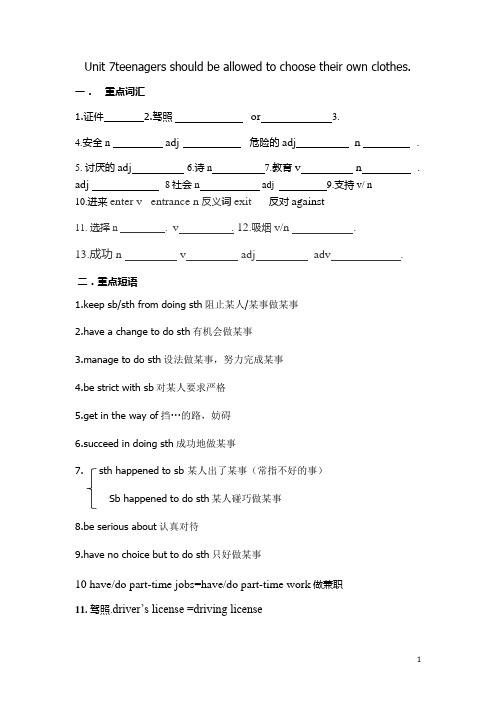
Unit 7teenagers should be allowed to choose their own clothes.一.重点词汇1.证件2.驾照 or3.4.安全n adj 危险的adj n .5. 讨厌的adj6.诗 n7.教育v n . adj 8社会n adj 9.支持v/ n10.进来enter v entrance n反义词exit反对against11. 选择n . v . 12.吸烟v/n .13.成功n v adj adv .二.重点短语1.keep sb/sth from doing sth阻止某人/某事做某事2.have a change to do sth有机会做某事3.manage to do sth设法做某事,努力完成某事4.be strict with sb对某人要求严格5.get in the way of挡···的路,妨碍6.succeed in doing sth成功地做某事7. sth happened to sb 某人出了某事(常指不好的事)Sb happened to do sth某人碰巧做某事8.be serious about认真对待9.have no choice but to do sth只好做某事10 have/do part-time jobs=have/do part-time work做兼职11.驾照.driver’s license =driving license12.拥抱某人give sb. a hug = hug sb.13.后悔做了… regret doing sth eg. I regret telling a lie.遗憾做…(没做) regret to sth eg.I regret to tell you that you failed the exam.14回嘴talk back 15.做出自己的决定make one’s own decision三、重点语法考点1.get/have/make sth done表被动 eg: have/get/make my ears piercedhave/get/make my hair cut2.should allow sb to do sthsb should be allowed to do stheg.We should allow teenagers to choose their own clothes.Teenagers should be allowed to choose their own clothes.Teenagers shouldn’t be allowed to choose their own clothes.Should teenagers be allowed to choose their own clothes?Why should teenagers be allowed to choose their own clothes?情态动词的被动语态是:情态动词(not)+be + done3.I don’t think sixteen-year-olds should be allowed to drive.若宾语从句跟在think 、believe 、suppose (猜想推测)guess(猜)image(想象) expect(期待)等动词之后,而主语为第一人称时,句子的否定体现在主句上。
Unit+7知识点归纳(短语+句型+语法) 人教版九年级英语全册+

人教版九年级U7知识点归纳(短语+句型+语法)Unit 7 Teenagers should be allowed to choose their own clothes.【重点短语】1. be allowed to do sth. 被允许干……allow sb. to do sth. 允许某人干……allow doing sth. 允许干……2. sixteen-year-olds =sixteen-year-oldboys and girls 16岁的孩子3. part-time jobs 兼职工作4. a driver’s license 驾照5. on weekends 在周末6. at that age 在那个年龄段7. on school nights 在上学期间的每个晚上8. stay up 熬夜9. clean up (相当与及物动词)清扫10. fail (in) a test 考试不及格11. take the test 参加考试12. the other day 前几天13. all my classmates 我所有的同学14. concentrate on 全神贯注于15.be good for 对…有益16. in groups 成群的,按组17. get noisy 吵闹(系表结构)18. learn from 向某人学习19. at present 目前,现在20. have an opportunity to do sth. 有做……的机会21.work hard 努力学习,努力工作22. think about 考虑23. be serious about sth. - 对某事认真24. be late for 迟到【重点句型】1. I don’t think twelve-year-olds should beallowed to get their ears pierced. 我认为不应该允许12岁的孩子穿耳孔。
人教版九年级英语Unit7考点汇总(语法、短语、知识点、作文)

九年级英语Unit7考点汇总(语法、短语、知识点、作文)Unit 7Teenagers should be allowed to choose their ownclothes.Part 1 常考词汇词型转换1.safe(adj.)安全的→(n.)safety安全→(adv.)safely安全地2.smoke(v.)吸烟→(现分)smoking3.part-time(adj.)兼职(的)→(对应词)full-time全职(的)4.pierce(v.)扎→(pt./pp.) pierced5.tiny(adj.)极小的,微小的→(反)huge巨大的6.hug(v./n.)拥抱→(pt./pp.)hugged→(现分)huggingcate(v.)教育→(n.)educator教育者→(n.)education→(adj.)educational有教育意义的8. manage(v.)完成→(n.) manager经理,管理者9.poem(n.)诗;韵文→(n.)poet诗人10.society(n.)社会→(adj.)social社会的11.ear(n.)耳朵→(n.)earring耳环;耳饰12.regret(v.)遗憾→(pt./pp.)regretted→(现分) regretting13.cry(v./n.)哭,叫喊→(pt./pp.)cried→(现分)crying14.bad(adj.)→(adv.)badly严重地,差→(比/最)worse/worstmunity(n.)社区,社团→(pl.)communities16.support(v./n.)支持→(n.)supporter支持者,拥护者17.enter(v.)进来,进去→(n.)entrance入口18.choose→(pt.)chose→(pp.)chosen→(n.)choice选择,挑选19.fair(adj.)公平的→(反) unfair不公平的→(n.)(un)fairnessPart 2 短语归纳Section A1.sixteen-year-olds =sixteen-year-old kids 16岁的孩子们2. go to the shopping center 去购物中心3. get one’s driver’s /driving license 取得驾驶执照4. no way 没门,不行5.have/ take part-time jobs = work part-time 做兼职工作6. get ears pierced 打耳洞get/have one’s hair cut 剪头发7. choose their own clothes 选择他们自己的服装8. serious enough 不够严肃9. be excited about (doing) sth. 对(做)…感到兴奋10. take lots of photos 拍许多照片11. all night 整夜use a flash 使用闪光灯12. stay by my side 陪伴在我的身旁13. run through the field 跑过田野14. make sure 确信15. keep sb./sth. (away) from 让某人/某物远离…16. give sb. a hug=hug sb. 拥抱某人17. lift up 举起(动副短语) lift it/them up18. talk back to sb. 跟某人顶嘴19.make one’s own decisions =decide for oneself自己做决定20. allow doing sth. 允许做某事allow sb. (not) to do sth. 允许某人(不)做某事be allowed to do sth. 被允许做某事21. cough badly 咳嗽得厉害22. go out with friends 和朋友外出23.have awful /scary dreams 做噩梦24.think back to those times 回顾过去那些时光25. stay out 待在外面move out 搬出去26. regret doing sth. 后悔做了某事(事已做)regret to do sth. 遗憾地去做某事(事未做)cate sb. to do sth. 教育某人做某事28.agree with sb. 同意某人的观点29.manage one’s own life 应付自己的生活30.in most Asian societies 在大多数亚洲社会Section B1.take the test参加考试pass the test通过考试fail a math test数学考试不及格take the test later补考2. get to class late=be late for class=arrive late for class3. be strict in sth. 在某方面要求严格be strict with sb. 对某人要求严格4. get in the way of…挡…的路,妨碍…5. support one’s dream 支持某人的梦想6. teenagers under eighteen 18岁以下的青少年7. have nothing against (doing) sth. 不反对(做)某事8. be serious about…对…认真,热衷于…= take…seriously9. spend more time on his homework在他的家庭作业上多花点时间10. care about sb. 关心/担心某人11. a professional runner 一名职业赛跑运动员12. end up as 最终成为…13. how much 多么(提问程度)14. enter university 进入大学15. make a choice (oneself) (自己)做选择have no choice but to do sth.除了做某事以外,别无选择16. hurt oneself 伤到自己17.have a chance to do sth. 有机会做某事18. reply to sb. = answer sb. 回答/答复某人Part 3 知识点总结01eight-year-olds 八岁大的孩子们【复数】eight-year-old 八岁大的…(放在名词前作定语) eight-years old 八岁(be后做表语)02stop doing sth 停止做某事stop to do sth. 停下来去做某事try doing sth 尝试做某事try to do sth 努力、尽力做....forget/remember doing 忘记/记得做过某事forget/remember to do 忘记/记得去做某事03get/have sth. done(过去分词) 让/使(别人)做某事如get their ears pierced 穿耳洞get/have my car made. (让别人)修我的车04形容词+enough如:beautiful enough 足够漂亮enough+名词如:enough food 足够食物enough+形/副to do sth. 足够…可以做…05be excited about (doing) sth. 对(做)某事感到兴奋= be excited to do sth. 对做某事感到兴奋06so+助动词/be//情态动词+主语意为:…也是neither+助动词/be//情态动词+主语意为:…也不是如:She is a student.So am I. = Me, tooShe isn’t a student.Neither/nor am I.= Me, neither.She will go to school. So will he. 她将去学校,他也是。
人教版九年级全一册unit7单元知识点总结

smoker no smoking
adj.兼职的
part-time 兼职工作
part-time job
v.扎;刺破;穿透
pierce 穿耳洞
n.耳饰;耳环
earБайду номын сангаасing 一副耳环
v.闪光;闪耀 n. 闪光;闪光灯
flash 手电筒
get one's ears pierced a pair of earrings flashlight
society adj. 社会的
social
get in the way of
support
v.进入;进来 n. 选择
enter 进入教室 进入大学 choice v.选择
做出选择
enter the classroom enter a college
choose 过去式 chose 过去分词 chosen make a choice
unit7知识点回顾
在此输入您的封面副标题
证;证件
licence 驾照
driver's licence
n.安全;安全性
driving licence safety
adj.安全的 adv.安全地
safe safely
n.危险 adj.危险的
danger dangerous
v.吸烟;冒烟
smoke n.吸烟者 n.禁止吸烟
poet communities
keep... away from stay... away from
机会;可能性
v.决定 n.决定
chance 有机会做某事
have chance to do sth
decide decision 自己做决定
人教版九年级英语上册课件:Unit 7单元知识归纳(共12张PPT)
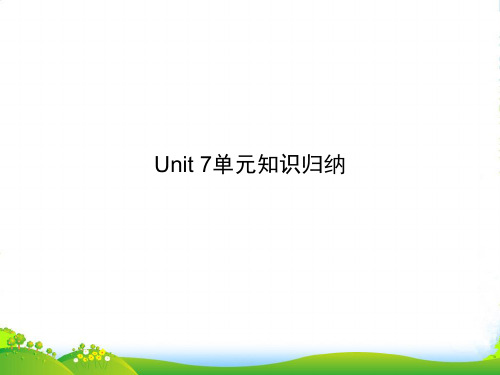
• Ⅱ.重点短语 • 1.the shopping center购物中心 • 2.driver’s license驾照 • 3.sixteen-year-olds 16岁的孩子 • 4.part-time jobs兼职工作 • 5.get one’s ears pierced穿耳洞 • get/have sth.done让……被做 • 6.at night在晚上
谢谢观赏
You made my day!
我们,还在路上……
人的梦想
• 39.every one of his races他的每一次 跑步比赛
• 40.against running反对跑步 • 41.end up以……结束/告终
• 42.decide for oneself由自己来决定 • 43.enter university进大学 • 44.be serious about sth./doing sth. • 对某事/做某事严肃/认真 • 45.care about关心;在乎 • 46.make this choice作出这种选择 • 47.in the end最后 • 48.keep off不(让)接近;让……处于关
机状态
• Ⅲ.经典句型 • 1.No way!没门儿!
• 2.I don’t think sixteen-year-olds should be allowed to drive.
•Hale Waihona Puke 我认为十六岁的孩子不应该被允许开 车。
• 3.Me,too.我也是。
• 4.When I was tired and hungry,she gave me food and warm arms to sleep in.
试…… • 32.fail a test考试失败 • 33.be strict with sb.对某人严格
人教版九年级英语UNIT7知识点总结

人教版九年级英语UNIT7知识点总结一、词语和词组1.allow sb. to do sth. 允许某人做某事(主动语态)be allowed to do sth. 被允许做某事(被动语态)2.get ears pierced 穿耳洞让/使(别人)做某事get/have sth. done3.stop doing sth. 停止做某事stop to do sth. 停止下来去做某事类似用法:continue继续;remember记得;forget忘记4.stay/sit up 熬夜5.clean up 打扫;整理clean sth. up或 clean up sth.;clean it up (当宾语为代词时;只能放在中间)6.人教版九年级英语UNIT7知识点总结go fishing(去钓鱼) go swimming(去游泳)go boating(去划船)go hiking(去登山)gotrekking/hiking(去徒步)7.人教版九年级英语UNIT7知识点总结8. take the test 参加考试 pass the test 通过考试 fail a test 考试失败9.the other day 前几天10.agree vi.同意(agreement n.) disagree v.不同意(disagreement n.)agree to (do) sth.(接受某物);同意做某事 agree with sb. 同意(某人的观点或看法)翻译:这就是我不同意她的地方。
_____________________________________________________________11.keep sb/ sth. +形容词(作宾补)使某人/某物保持….12. have an opportunity to do sth. 有机会做某事have a chance of doing sth. 有机会做某事两个词都表示机会;但是chance倾向于“机会”;opportunity倾向于“机遇”13.at present 目前14.at least 最少 at most 最多15.have +时间段+off 放假;休息16.reply to 答复某人17.get in the way of 碍事;妨碍18.关于“experience”的词的区分:experience v.经历 n. 【C】经历【U】经验19.关于“成功”的词的区分:人教版九年级英语UNIT7知识点总结succeed v.成功 successfully adv. 成功地successful adj.成功的人教版九年级英语UNIT7知识点总结19.think about 与think of 的区别①当两者译为:认为、想起、记着时;两者可互用例句:I often think about/ of that day. 我经常想起那天。
人教版九年级英语Unit7知识点梳理及语法讲义(教师版)
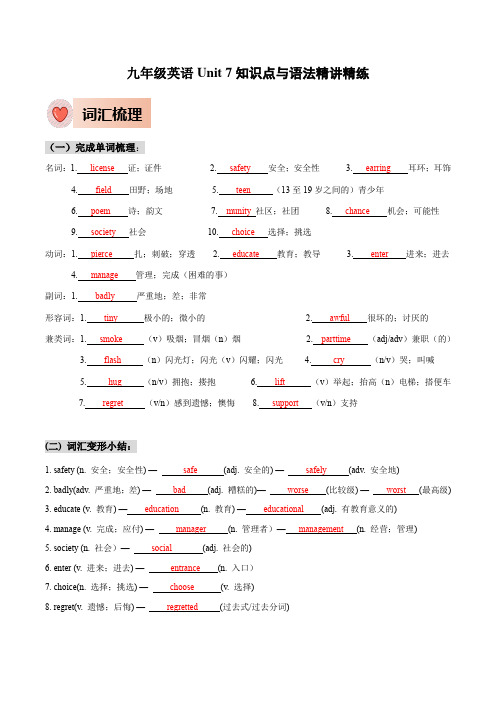
九年级英语Unit 7知识点与语法精讲精练词汇梳理(一)完成单词梳理:名词:1. license证;证件 2. safety 安全;安全性 3. earring 耳环;耳饰4. field 田野;场地5. teen (13至19岁之间的)青少年6. poem 诗;韵文7. munity 社区;社团8. chance 机会;可能性9. society 社会10. choice 选择;挑选动词:1. pierce 扎;刺破;穿透 2. educate 教育;教导 3. enter 进来;进去4. manage 管理;完成(困难的事)副词:1. badly 严重地;差;非常形容词:1. tiny 极小的;微小的 2. awful 很坏的;讨厌的兼类词:1. smoke (v)吸烟;冒烟(n)烟 2. parttime(adj/adv)兼职(的)3. flash (n)闪光灯;闪光(v)闪耀;闪光4. cry (n/v)哭;叫喊5. hug (n/v)拥抱;搂抱6. lift (v)举起;抬高(n)电梯;搭便车7. regret (v/n)感到遗憾;懊悔8. support (v/n)支持(二) 词汇变形小结:1. safety (n. 安全;安全性) — safe (adj. 安全的) — safely (adv. 安全地)2. badly(adv. 严重地;差) — bad (adj. 糟糕的)— worse (比较级) — worst (最高级)3. educate (v. 教育) — education (n. 教育) — educational (adj. 有教育意义的)4. manage (v. 完成;应付) — manager (n. 管理者)— management (n. 经营;管理)5. society (n. 社会)— social (adj. 社会的)6. enter (v. 进来;进去) — entrance (n. 入口)7. choice(n. 选择;挑选) — choose (v. 选择)8. regret(v. 遗憾;后悔) — regretted (过去式/过去分词)【练一练】用所给词的适当形式填空1.We were worried about the children’s ___safety_____ (safe).2.They are talking about Chinese ___education____ (educate).3.Staying up too late to look through those ___social_____ (society)media web pages is bad for our health.4.My father used to be a heavy ____smoker____(smoke). But now he is a healthy person after giving it up.5.The little boy had no ____choice _____ (choose) but to wait outside.6.The Belt and Road Forum(一带一路高峰论坛)____held_____(hold) successfully in Beijing last month.7.When I realized my mistake, I ___regretted____ (regret) not taking my mother’s advice.8.The old man was hit by a car and his right leg was _____badly_____ (bad) hurt.9.What will happen to him if he doesn’t ___succeed_____ (success)?10.The plane was checked carefully after ____landing_____ (land) successfully last weekend.(三) 短语攻关:talk back 回嘴;顶嘴keep...away from 避免接近;远离make one’s own decision自己做决定get in the way of 挡……的路;妨碍driver’s license 驾照be worried about担心be excited about 对……感到兴奋think back 回想be strict with sb 对某人要求严格be strict about/in sth对某事要求严格end up 最终成为in the end 最后make a choice 做出选择lift up 举起make sure 确保give sb a hug 给某人一个拥抱get sth done 使某事被做regret doing sth 后悔做了某事regret to do sth 很遗憾去做某事continue to do sth继续做某事知识点梳理1.I don’t think sixteenyearolds should be allowed to drive. 我认为不应该允许16岁的青少年开车。
- 1、下载文档前请自行甄别文档内容的完整性,平台不提供额外的编辑、内容补充、找答案等附加服务。
- 2、"仅部分预览"的文档,不可在线预览部分如存在完整性等问题,可反馈申请退款(可完整预览的文档不适用该条件!)。
- 3、如文档侵犯您的权益,请联系客服反馈,我们会尽快为您处理(人工客服工作时间:9:00-18:30)。
2019-2020学年人教版英语九年级U7 Teenagers should be allowed to choose their own clothes课题:Teenagers should be allowed to choose their own clothes重点:⑴掌握本单元出现的生词、短语⑵学习运用含有情态动词的被动语态难点:⑴含有情态动词的被动语态⑵“某人也是”的表达方式⑶“使某事被做、让别人做某事”的表达方式主要知识点:1、含有情态动词被动语态的构成:情态动词+be+及物动词的过去分词(Ved)【例句】:1、We should be allowed to watch TV on weekends.2、The work must be done at once .例:We should look after the children carefully .(改为被动句)The children ______ ______ ______ _______ _______ .解析:此题考查含有情态动词should的被动语态,其结构为“should+be+动词的过去分词”答案:should be looked after carefully2、宾语从句的否定前移:当宾语从句跟在think、believe、suppose,expect等的动词后,且主句主语是第一人称(I,we), 变否定句时,要在主句上否定,即“否定转移”;变反意疑问句时,附加问句要与从句一致。
【例句】:1、I think you are right.-------否定句:I don’t think you are right .2、I don’t think he is clever,is he ?【注】:若主句的主语是第二、三人称,变否定句时,要在从句上否定;变反意疑问句时,附加问句要与主句一致。
【例句】:They think you are right .否定句:They think you are not right .反意疑问句:They think you are right,don’t they ?例:I don’t think the newly-directed film by Zhao Wei is as interesting as people say, _______ ?A. do youB. isn’t itC. is itD. don’t you解析:若主句的主语为第一人称,宾语从句跟在think,believe,suppose等的动词后,变为反意疑问句时,附加问句要根据从句来确定。
答案:选C3、sixteen-year-old s= sixteen-year-old teenagers 十六岁的青少年(名词)【例句】: Fifty-year-olds should retire.【注】: 1、“基数词-名词(单数)-形容词”通常用作形容词,作前置定语【例句】:She is an eight-year-old girl.2、sixteen-year-old十六岁的(形容词)sixteen years old 十六岁【例句】: The boy is five years old. = He is a five-year-old boy.4、be allowed to do sth. 被允许做某事【例句】: Students are not allowed to talk in class.【注】: 1、allow sb to do sth 允许某人做某事【例句】: The teachers allowed him to go into the classroom.2、allow doing sth 允许做某事【例句】: We don’t allow smoking in public.例:---“Should a teenager ______ to get a driving license?”---“First go to a training center.”A. be allowB. allowC. be allowedD. Allowed解析:含有情态动词被动语态的构成:情态动词+be+及物动词的过去分词。
Be allowed to do sth 意为”被允许做某事”答案:选C.5、get sth done 意为“使某事被做、让别人做某事”,其中过去分词表示的动作往往是别人做的,与句子的主语无关【例句】: 1、get their ears pieced 扎耳洞2、get your hair cut 剪头发例:He wants to get his TV ______ .A. repairingB. repairedC. to repairD. Repairs解析:get sth done 意为“让某是被做”。
结合句意“他想让别人给他修电视”,可知选B答案:选B6、stop doing sth 与stop to do sth 的区别①stop doing sth “停止做某事”,指停止正在做的事情②stop to do sth “停下来去做另一件事”,指停止正在做的事情去做另一件事【例句】: 1、It’s time for class. Please stop talking .2、They stopped to do their homework.例:Dad, you have worked for three hours. Stop ____ and have a rest,please.A. to workB. workingC. workD. works解析:stop to do sth “停下来去做另一件事”,stop doing sth “停止做某事”,根据句意可知此题选B答案:选B【注】:stop sb. from doing sth. 阻止某人做某事【例句】: We must stop him from throwing the rubbish everywhere .7、wear,put on,dress与(be) in①wear 穿着;戴着......,表状态;后接衣帽,也可接饰物、奖章等②put on 穿上;戴上......,表动作;后接衣服、帽子等③dress (给......)穿衣服,表动作;后接人作宾语④(be)in 穿着,表状态,后接表示衣服或颜色的名词【例句】: 1、The children are wearing nice clothes today.2、Put on warm clothes, or you will catch a cold .3、He dressed himself every morning .4、The girl in red is his daughter.8、bring , take 与fetch的区别①bring 带来;拿来(从别处带到说话者处)②take 拿走;带走(从说话者处拿到别处)③fetch 去取来(既包括去又包括来)【例句】:1、Bring your friends to the party.2、Take the letter to the post office.3、I asked her to fetch me an evening paper.9、anyway 副词,意为“无论如何;尽管如此;反正”【例句】:I don’t care what you say. I’m going to do it anyway.10、疑问词(who、whom、whose、what、when、where、how)+动词不定式(to do)【例句】:I am thinking about how to solve the problem.例:---I don’t know ________ next .---You’d better finish your homework first.A. what to doB. how to doC. when to do解析:根据答语可知此题是说“我不知道下一步做什么”,故选A答案:选A11、regret doing sth 与regret to do sth①regret doing sth 对做过的事感到遗憾、后悔(已做)②regret to do sth 对要做的事感到遗憾(未做)【例句】:1、I regret telling her what I thought .2、I regret to have to do it ,but I have no choice .12、agree 动词,同意;赞成;承认【反义词】disagree①agree with 表示“同意某人”或“同意某人的意见、观点”等②agree to 主要用来表示一方提出一项建议、安排、计划等,另一方同意协作③agree on 主要指双方通过协商后在某一点上取得一致意见或达成协议④agree to do sth 同意做某事⑤agree+(that)从句意为“同意,赞同...”【例句】:1、I agree with what you said .2、He agreed with me .3、I agreed to their arrangement .4、We agreed on the question.5、I agreed to start early .6、She agreed that I was right .13、get in the way of... 意为”挡...的路;妨碍....”,与be in the way of同义。
【例句】:Playing computer games can get in the way of his study .14、achieve 及物动词,意为“实现;(尤指经过努力)取得;达到”【例句】:I am sure he will achieve his dream in the end.She achieved very good exam results.【注】:achieve与come true①achieve意为“实现”,其主语通常是人②come true 意为“实现”,其主语通常是梦想等【例句】:She achieved her dream.Her dream came true.15、against介词,意为“反对;违背”,【反义词】for,意为“支持”【例句】:All the people in the world are against war.【注】:have nothing against sth/doing sth 意为“不反对某事、做某事”【例句】:I have nothing against singing loudly.16、happen不及物动词,意为“发生”,其用法如下①Sth +happened +地点、时间,意为“某地(某时)发生了某事”【例句】:An accident happened in that street.②Sth+happened to sb ,意为“某人除了某事(常指不好的事)”【例句】:A car accident happened to her this morning.③Sb+happened+to do sth 意为“某人碰巧做某事”【例句】:I happened to meet a friend of mine in the street yesterday.【注】:happen与take place 的区别①happen“发生;碰巧”,一般用于偶然或突发性事件【例句】:How did the accident happen ?②take place“发生;举行;举办”,一般只非偶然性事件的“发生”,即事件的发生有某种原因或事先经过安排【例句】:The celebration ceremony takes place in July every year. 17、choice可数名词,意为“选择;抉择” 【动词】choose【例句】:He is faced with a difficult choice.【注】:have no choice but to do sth 除做某事外别无选择【例句】:I have no choice but to accept the fact.18、“Only+状语”引导的倒装句:句首的only+ 副词、介词短语或从句等状语(从句),则句子要用部分倒装结构。
